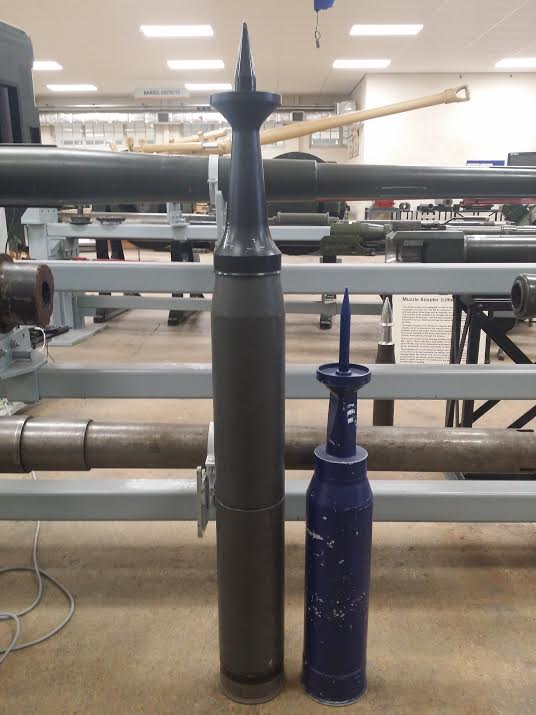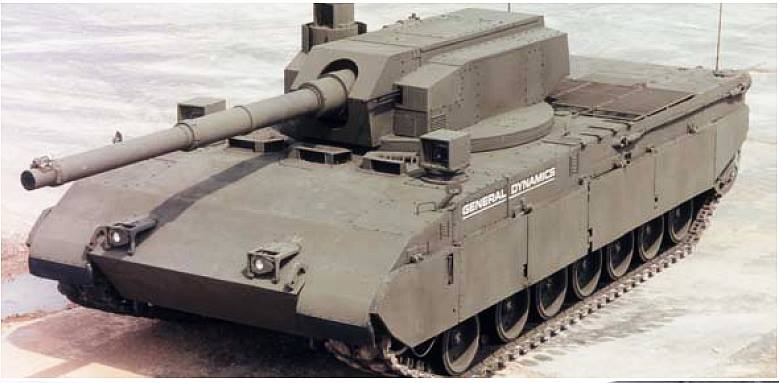Let’s talk some more about the 140 mm tank gun, that late cold war weapon that never was. Perfect for killing Soviet Supertanks that never were. And making your new tank way cooler than everyone else’s. The fastest way to get more armor penetration is to just build a bigger gun with more muzzle energy. A lot more.
As you might imagine, a 140 mm round is quite a bit bigger than a 120mm round. Let’s take a look, because these numbers are damned hard to find:
First, a typical 120 mm APFSDS round for the era, the American M829A1. The legendary Silver Bullet that slaughtered the tanks of Saddam’s Republican Guard. Some variations in length and weight are to be expected amongst 120 mm rounds. Newer rounds are a little heavier, but the size is constrained by ammunition storage racks and the existing chambers. The M829A1 is also the round that was in service while the 140 mm was under development.
M829A1 120 mm APFSDS
* Length: 984 mm
* Weight: 20.9 kg (46 lbs)
And now, the round to replace it. Producing 23 MJ at the muzzle, more than double that of the 120mm. The mighty 140. Dimensions were fixed by the NATO countries that were all developing their own versions of the round.

XM962 140 mm APFSDS
* Length: 1,482 mm
* Weight: approximately 40 kg (88 lbs)
The length and weight of the 140 mm stand out. This round would have been a royal pain to handle. It’s also a bit fatter, so autoloaders could handle fewer rounds. This explains why the K2 Black Panther, otherwise similar to the Leclerc, can only hold 17 rounds in its autoloader compared to 22 in the Leclerc. The K2 is ready for 140 mm, needing only a barrel change. Interestingly, the round count in the Black Panther matches those for the M1-CATTB prototype, which had a similar, belt-style autoloader in its bustle. Don’t worry, we’ll talk about the CATTB in a future article.
NATO-standard 120 mm rounds like the M829A1 are unitary rounds. One big piece, like an oversized version of the cartridges you load into your guns at home. Because of the large size of the 140 mm rounds, these were made as two-piece rounds. Unfortunately, while I can find dimensions for the round’s overall length, I don’t have dimensions for the pieces. Until I can find one to measure myself, we’ll have to make do with some pixel counting/scaling, which yields a length of about 1,024 mm for the upper part of the round, and about 461 mm for the lower part. Which is still big and annoying for autoloader development. Length of the upper part of the round is heavily influenced by the length of the APFSDS projectile. This also would affect a design using a carousel autoloader like the TTB, since carousel (and therefore hull) height and turret height are constrained by the requirement to lift and rotate the rounds into position.
Based on the standards of the day, the 140 mm gun made more than twice the energy of the 120 mm at the muzzle. Of those 23 MJ of muzzle energy in the 140 mm, 14 MJ goes to the penetrator. Running the numbers meant that the 140 mm APFSDS could punch through more than 1,000 mm of RHAe at a ‘battle range’ of 2 km. For comparison, we’ll pull some open source estimates for M829A1, which give it a penetration of 700 mm of RHAe1.
Now, those are some really good numbers2. Of course, there’s a price to be paid. Even with the two-piece construction, everyone working with the 140 mm designed with autoloaders. Which meant significantly reworked turrets for the British, the Germans, and the Americans at a minimum. Plus, ammunition capacity would drop.
Upgunning to a 140 mm round was the simplest way to get a lot more armor penetration capability into a tank. At least from a weapon/projectile design standpoint. It would have required some serious reworking of then-extant designs, but such is life. When the Soviet Union imploded, the armored threat of the projected Future Soviet (super)tanks evaporated, and the 140 mm gun projects were quietly shelved. 120 mm rounds are continuing to get more development and the latest are quite a bit more effective than the M829A1. Lower cost, likely lower capabilities, but this decision makes sense given the circumstances.
- There’s some variation in this estimation depending on source. Open source disclaimers apply, etc. ↩
- They’re also a trifle disingenuous. Nobody is armoring their tanks with a meter of rolled homogenous steel. Literally nobody. A more advanced penetrator design can exploit effects on the not-steel that people actually armor their tanks with. Similarly, the armor might be designed to radically degrade (read: break up) the penetrator, which can be sort of but not really captured in RHAe estimations. So the RHAe numbers don’t actually tell the whole story on either side of the design puzzle. Oh, and the numbers themselves are the usual open-source estimates3, so they’re probably all wrong. ↩
- If you’d like to try your hand, start running through the Odermatt equation. And then remember that Odermatt wrote for tungsten-based penetrators, and M829A1 is depleted uranium, so you’ll need to tweak it. ↩

